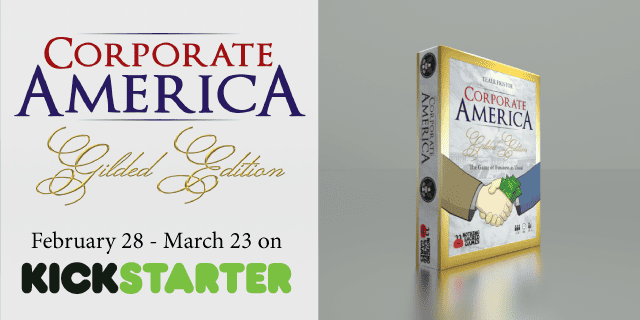
Four years ago, I put Corporate America up on Kickstarter. Like many first time creators, I made a lot of mistakes: the overall goal was much too high; the game was too big and expensive for a first time publisher; and the video was confusing and convoluted. (And that’s just naming a few!) Despite all that, the campaign managed to hobble past the finish line, thanks in large part to the support of very generous friends and family.
Another common mistake I made was not planning much past the Kickstarter. I had a solid game and the money to make it, but I didn’t know where I’d put all those games, or how I’d sell them. After a last minute scramble, I managed to find some folks in the industry to work with, and Corporate America somehow snuck into distribution. Soon, word of mouth started to spread, and after a year and a half the game was sold out. That’s every first time creator’s dream, right!?
Actually, reprinting is every first time creator’s dream. But Corporate America was big and expensive, and it wasn’t clear to me that I could sell through a whole additional print run. So I turned my attention towards other projects.

Ok, you still can get Corporate America, if you’re willing to part with $170.
But Corporate America just wouldn’t go away. Its resonant theme, genuine humor, and unique gameplay meant that word about the game continued to spread. To this day I still receive frequent questions about how to get the game (spoiler: you can’t) and people even buy the print and play.
With so much lingering demand, I finally decided to not only bring Corporate America back, but improve the game with a second edition (I’ve learned a lot in four years, after all). But I don’t have the big pile of money lying around I need to print out of pocket. So in addition to updating the game, I’ve spent a good amount of time preparing for a second Kickstarter.
This isn’t very common. Usually if a game needs a reprint or a second edition, the publisher will pay for it with profits from the first print run. But that’s just not possible for Corporate America. So today I thought I’d discuss some of the major differences between running a Kickstarter for a first print run of a game and running a Kickstarter for a second edition.

REVIEWS, NOT PREVIEWS
When you have a new game, very few people have played it, but it’s essential that people believe it’s both playable and fun. So as a Kickstarter creator, you need to go out of your way to find trusted reviewers to play your game and like it enough to tell people it’s worth their money. And given the barrage of requests many reviewers get about Kickstarter games, they often charge for these previews, which makes them a little less trustworthy.

A prominent top 10 list is far more convincing than a paid Kickstarter preview.
After a game has been released, though, it should have reviews that give a much better idea of the actual play experience. You won’t have to pay for the bare minimal exposure; instead, you can pick and choose the reviews you want to include that best present the game to your target audience. For Corporate America, that includes favorable responses from trusted board game reviewers, including making Tom Vasel’s top 10 political games, Dan King’s top 10 games of 2013, and Forrest Bower’s #3 game of all time, as well as acclaim from political activists, such as glowing write-ups in the San Francisco Chronicle and from Molleindustria. Even Max Temkin, designer of Cards Against Humanity, called the game “a perfect blend of game mechanics and political commentary”!
Having actual reviews means less work for the creator, since you don’t have to chase expensive previews last minute, and it should also fill potential backers with more confidence, since reviews tend to be more balanced between praise and criticism. (Previews rarely express disappointment or negativity. If a previewer doesn’t like a game, he or she will usually just not create a preview rather than potentially sinking a game (and dream) that hasn’t even been made yet.)
MULTIPLE AUDIENCES
Recall that the original Corporate America Kickstarter just barely scraped by, in large part due to generous family and friends. Those folks already have Corporate America, so for the first time after three Kickstarters, I won’t be able to count on a strong foundation from my personal support network. This definitely makes me nervous going into the campaign!

I want existing fans of Corporate America to be able to get in on the new fun without having to buy a whole new copy of the game.
That said, the original and the gilded editions of Corporate America will be very different, and I know existing owners will be excited to experience the changes. So to let previous owners get in on the new version and the thrill of the Kickstarter without breaking bank, I’m going to offer an “upgrade pack” that includes the cards from the new edition without many of the other expensive components (board, box, wooden tokens, etc). At a $20 price point, this is affordable, but still a meaningful contribution towards a successful Kickstarter.
JUSTIFICATION
Running a second Kickstarter may require less defense of the game itself (the reviews should do that for you), but it does require a defense of why you’re bothering with Kickstarter at all. Shouldn’t you just be paying out of pocket for a reprint like most publishers? I don’t plan on dwelling on this in the Kickstarter, but I will address it briefly. And I have two responses.
First, while I was capable of making a great game when I ran the first Kickstarter, I had a lot to learn when it came to running a business. So even though popular and critical acclaim prove that Corporate America was an artistic success, poor pricing and inefficient shipping meant it wasn’t terribly successful from a financial perspective. A second Kickstarter allows me to bring the great gameplay to many eager gamers who missed out the first time, while at the same time starting a more sustainable business.
Second, this isn’t just a reprint, it’s a new edition! Every aspect of the game is being improved, from core rules to balancing to graphic design to component quality. Though it’s less costly than a completely new game, it’s quite a bit more expensive than a simple reprint.
Of course, there’s also the important marketing aspect of Kickstarter. For a small publisher like Nothing Sacred Games in particular, making a large game like Corporate America is a huge risk, and one misstep can completely knock the company out of business. Running a Kickstarter lets me test the water before I plunge in. Even though I’m confident a new edition of Corporate America will do well, Kickstarter lets me know for sure.
RIDE THE COASTER
In one of my first articles for the League of Game Makers, I discussed how Kickstarter is an emotional roller coaster. Even after three previous successful Kickstarters, I have no doubt that the Corporate America Gilded Edition campaign will have many surprise twists and turns. I hope you’ll join me for the ride!
But what do you think? Are there any other important differences between a first print run Kickstarter and a second edition Kickstarter? Any words of wisdom you can offer me as I embark on this crazy journey? Let me know in the comments below!








